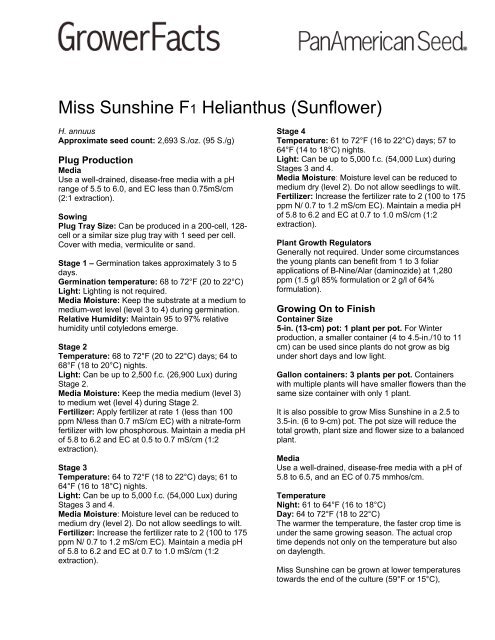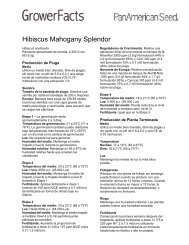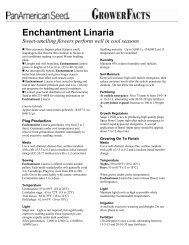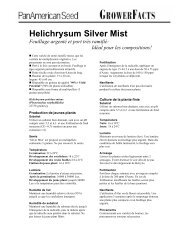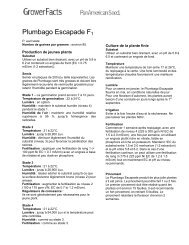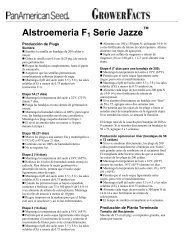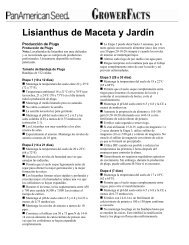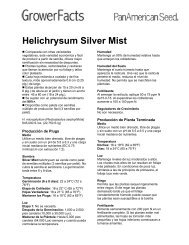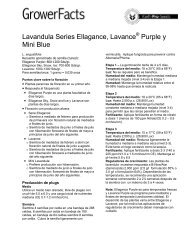Miss Sunshine F1 Helianthus (Sunflower)
Miss Sunshine F1 Helianthus (Sunflower)
Miss Sunshine F1 Helianthus (Sunflower)
You also want an ePaper? Increase the reach of your titles
YUMPU automatically turns print PDFs into web optimized ePapers that Google loves.
<strong>Miss</strong> <strong>Sunshine</strong> <strong>F1</strong> <strong>Helianthus</strong> (<strong>Sunflower</strong>)<br />
H. annuus<br />
Approximate seed count: 2,693 S./oz. (95 S./g)<br />
Plug Production<br />
Media<br />
Use a well-drained, disease-free media with a pH<br />
range of 5.5 to 6.0, and EC less than 0.75mS/cm<br />
(2:1 extraction).<br />
Sowing<br />
Plug Tray Size: Can be produced in a 200-cell, 128-<br />
cell or a similar size plug tray with 1 seed per cell.<br />
Cover with media, vermiculite or sand.<br />
Stage 1 – Germination takes approximately 3 to 5<br />
days.<br />
Germination temperature: 68 to 72°F (20 to 22°C)<br />
Light: Lighting is not required.<br />
Media Moisture: Keep the substrate at a medium to<br />
medium-wet level (level 3 to 4) during germination.<br />
Relative Humidity: Maintain 95 to 97% relative<br />
humidity until cotyledons emerge.<br />
Stage 2<br />
Temperature: 68 to 72°F (20 to 22°C) days; 64 to<br />
68°F (18 to 20°C) nights.<br />
Light: Can be up to 2,500 f.c. (26,900 Lux) during<br />
Stage 2.<br />
Media Moisture: Keep the media medium (level 3)<br />
to medium wet (level 4) during Stage 2.<br />
Fertilizer: Apply fertilizer at rate 1 (less than 100<br />
ppm N/less than 0.7 mS/cm EC) with a nitrate-form<br />
fertilizer with low phosphorous. Maintain a media pH<br />
of 5.8 to 6.2 and EC at 0.5 to 0.7 mS/cm (1:2<br />
extraction).<br />
Stage 3<br />
Temperature: 64 to 72°F (18 to 22°C) days; 61 to<br />
64°F (16 to 18°C) nights.<br />
Light: Can be up to 5,000 f.c. (54,000 Lux) during<br />
Stages 3 and 4.<br />
Media Moisture: Moisture level can be reduced to<br />
medium dry (level 2). Do not allow seedlings to wilt.<br />
Fertilizer: Increase the fertilizer rate to 2 (100 to 175<br />
ppm N/ 0.7 to 1.2 mS/cm EC). Maintain a media pH<br />
of 5.8 to 6.2 and EC at 0.7 to 1.0 mS/cm (1:2<br />
extraction).<br />
Stage 4<br />
Temperature: 61 to 72°F (16 to 22°C) days; 57 to<br />
64°F (14 to 18°C) nights.<br />
Light: Can be up to 5,000 f.c. (54,000 Lux) during<br />
Stages 3 and 4.<br />
Media Moisture: Moisture level can be reduced to<br />
medium dry (level 2). Do not allow seedlings to wilt.<br />
Fertilizer: Increase the fertilizer rate to 2 (100 to 175<br />
ppm N/ 0.7 to 1.2 mS/cm EC). Maintain a media pH<br />
of 5.8 to 6.2 and EC at 0.7 to 1.0 mS/cm (1:2<br />
extraction).<br />
Plant Growth Regulators<br />
Generally not required. Under some circumstances<br />
the young plants can benefit from 1 to 3 foliar<br />
applications of B-Nine/Alar (daminozide) at 1,280<br />
ppm (1.5 g/l 85% formulation or 2 g/l of 64%<br />
formulation).<br />
Growing On to Finish<br />
Container Size<br />
5-in. (13-cm) pot: 1 plant per pot. For Winter<br />
production, a smaller container (4 to 4.5-in./10 to 11<br />
cm) can be used since plants do not grow as big<br />
under short days and low light.<br />
Gallon containers: 3 plants per pot. Containers<br />
with multiple plants will have smaller flowers than the<br />
same size container with only 1 plant.<br />
It is also possible to grow <strong>Miss</strong> <strong>Sunshine</strong> in a 2.5 to<br />
3.5-in. (6 to 9-cm) pot. The pot size will reduce the<br />
total growth, plant size and flower size to a balanced<br />
plant.<br />
Media<br />
Use a well-drained, disease-free media with a pH of<br />
5.8 to 6.5, and an EC of 0.75 mmhos/cm.<br />
Temperature<br />
Night: 61 to 64°F (16 to 18°C)<br />
Day: 64 to 72°F (18 to 22°C)<br />
The warmer the temperature, the faster crop time is<br />
under the same growing season. The actual crop<br />
time depends not only on the temperature but also<br />
on daylength.<br />
<strong>Miss</strong> <strong>Sunshine</strong> can be grown at lower temperatures<br />
towards the end of the culture (59°F or 15°C),
Light<br />
Keep light levels as high as possible while<br />
maintaining appropriate temperatures. High light<br />
gives a stronger stem, larger primary flowers and<br />
more secondary buds.<br />
Daylength<br />
<strong>Miss</strong> <strong>Sunshine</strong> can be produced year-round.<br />
Photoperiod trials have shown that <strong>Miss</strong> <strong>Sunshine</strong><br />
flowers 1 week faster at 10-hour days compared to<br />
14-hour days, and 2 weeks faster at 10-hour days<br />
compared to 16-hour days. However, cooler<br />
temperatures associated with short days can result<br />
in longer crop time.<br />
Crops grown during the Summer can be black<br />
clothed to create 12-hour days.<br />
Irrigation<br />
Do not overwater. Allow the medium to moderately<br />
dry, then water thoroughly. Avoid watering in the late<br />
afternoon as the foliage will stay wet during the night<br />
and create an environment favorable for powdery<br />
mildew.<br />
Fertilizer<br />
Apply fertilizer at rate 3 (175 to 225 ppm N/1.2 to1.5<br />
mS/cm EC) once a week from a nitrate-form fertilizer<br />
with low phosphorus. A balanced ammonium and<br />
nitrate-form fertilizer may be applied as needed.<br />
Maintain the media EC at 1.5 to 2.0 mS/cm and pH<br />
at 5.8 to 6.2.<br />
For constant fertilizer program, fertilizer can be<br />
applied at rate 2 (100 to 175 ppm N/0.7 to 1.2<br />
mS/cm) while maintaining the above recommended<br />
EC and pH ranges.<br />
Plant Growth Regulators<br />
PGRs are generally not required under short-day<br />
conditions. Under short days and cooler growing<br />
conditions, plants will grow 6 to 8 in. (15 to 20 cm).<br />
Under long days and warmer growing conditions,<br />
plants will grow up to 10 to 12 in. (25 to 30 cm) tall.<br />
If it is necessary to control height, spray with B-Nine/<br />
Alar (daminozide) at 1,250 to 2,500 ppm (1.5 to 3 g/l<br />
85% formulation or 2 to 4 g/l of 64% formulation).<br />
Usually 1 application at the end of the crop time is<br />
enough.<br />
PGR treatments can delay flowering a few days.<br />
Crop Scheduling<br />
Sow to transplant (200-cell plug tray): 2 to 3<br />
weeks. Add 1 more week for larger liners (128-cell).<br />
Transplant to flower: Summer/Fall: 6 to 7 weeks,<br />
Winter/early Spring: 7 to 8 weeks.<br />
For northern Europe: Summer/Fall: 7 to 8 weeks,<br />
Winter/early Spring 9 to 11 weeks.<br />
Common Problems<br />
Insects: Aphids<br />
Diseases: Powdery mildew; however, <strong>Miss</strong><br />
<strong>Sunshine</strong> is more resistant to powdery mildew than<br />
other commercial varieties.<br />
Note: Growers should use the information presented<br />
here as a starting point. Crop times will vary<br />
depending on the climate, location, time of year, and<br />
greenhouse environmental conditions. Chemical and<br />
PGR recommendations are only guidelines. It is the<br />
responsibility of the applicator to read and follow all<br />
the current label directions for the specific chemical<br />
being used in accordance with all regulations.<br />
630 231-1400<br />
panamseed.com<br />
© 2008 Ball Horticultural Company PAS09009-Eng<br />
denotes a trademark of and ® denotes a registered trademark of Ball Horticultural Company in the<br />
U.S. It may also be registered in other countries.


